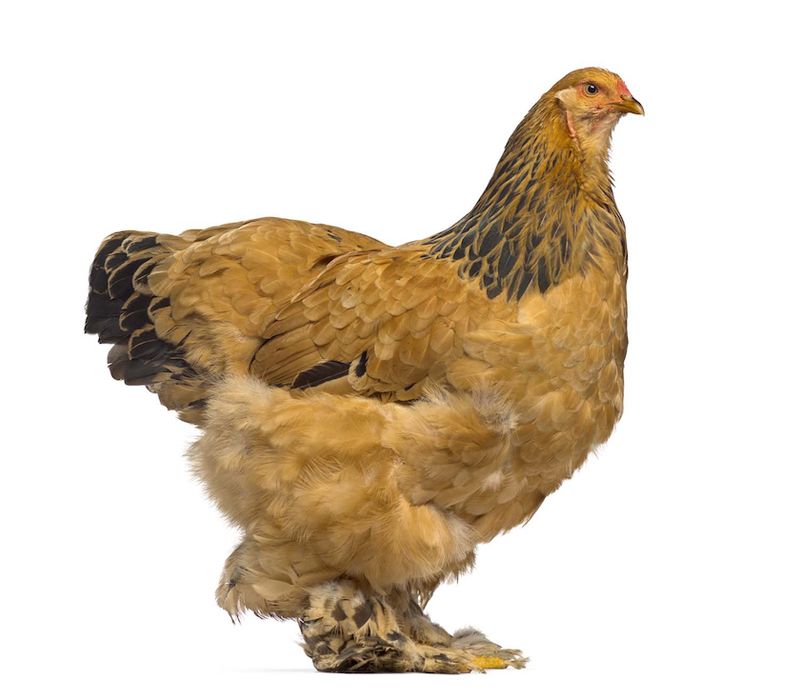Behold, the Mighty Brahma!


A chicken worthy of your back yard
Big, bold, and beautiful describes the Brahma breed perfectly. Great layers, cold-hardy, with lovely feathered toes and legs…overall it’s just a unique bird ideal for beginner flock raisers. Could this “large and in charge chicken” fit in backyard brigade?
When hen fever was a good thing
Brahmas came from the Victorian era (mid-1800’s) when people were going bonkers over raising hens.
These birds have a rather mutt-like heritage, with their ancestors likely including Shanghais, Chittagongs, and Malays. These particular breeds originated from China all the way to Eastern India…a rather scrambled (egg pun intended) lineage to say the least!
They were imported into the U.S. around 1840. Being nameless, a meeting of poultry judges in Massachusetts declared their official name to be “Brahmaputra” (from a river flowing from Tibet through Bangladesh), or Brahma, for short.
Who shortened the name?
T.B. Miner, publisher of “The Northern Farmer,” did so in the 1850s simply to save space on his printed pages.
Because the birds were so enormous, they started out as primarily meat chickens from the 1840’s until the 1930’s. Only later was their popularity as egg producers recognized.
Nearly a yard of bird
Brahmas are certainly head-turners. They stand very upright, making them appear even larger than they already are, often towering over the rest of their flockmates at an impressive 30 inches tall and weighing in at a hefty 8 to 10 pounds, if not even heavier.
However, the bulk of these birds are their feathers which are very dense, fluffy, and tightly packed, covering the outside of their legs and feet. They have large heads and peacombs with a slightly overhanging brow. This gives them an imposing look.
They come in a limited variety of colors including buff, white, and black. Some can be speckled black and white, though these are considered rare.

Big bird, mild personality
These big hens are wonderfully gentle and patient, making them perfect for beginner chicken parents or for children. They are very placid and aren’t known to bully their flockmates, though they can get a bit pushy with food. Hey, they’re bigger and these big birds come with big appetites! So, be sure to keep the feeder full. They are also rather quiet birds who prefer to keep bickering at a minimum, which should make neighbors happy.
Brahmas are cold-hardy and do well in milder weather; but be sure to provide them with some shade during the hotter months.
Due to their heft, they don’t make very good flyers and can easily be contained with 2-foot tall fences; that said, providing them with a lower roost (12-18 inches tall) would be appreciated.
They also require more roaming room than your average-sized chicken, with 5-6 feet per chicken being ideal to prevent bad behaviors like pecking and feather picking.
Are they hard to care for?
The Number One issue with Brahmas would be their fluffy feathers. Feathers and wet conditions do not mix, so keep these birds out of the mud.
They can also have issues with debris getting caught in their feathered feet, so weekly foot checks is a good routine to get into. Overall, these birds are robust and easy-keepers.
But they are egg layers, too
Brahmas take their time when they first start laying, up to 7 months. Once they get working, however, they will provide you with 3-4 medium brown eggs a week, like clockwork.
These hens prefer to lay in cooler weather, so they will produce all throughout the winter and slow down once spring hits…which is ideal because that’s when other hens start to ramp up.
They are not known to be broody, but those that do are very determined egg-sitters. It is wise to nip this habit quickly so these bulky birds don’t accidentally crush the eggs they are trying to hatch.
An impressive coop addition
Would Brahmas would make a wonderful addition to your coop? They are prolific egg-layers (though slow to start) and tend to lay when other chickens take a break, which keeps your egg cartons filled all year-long!
These attractive hens are gentle and easy-going for newbies or children, plus their exquisite plumage will certainly attract attention. Let’s hear it for the mighty Brahma!
Tags:Chicken Chatter

Acreage Life is part of the Catalyst Communications Network publication family.
















